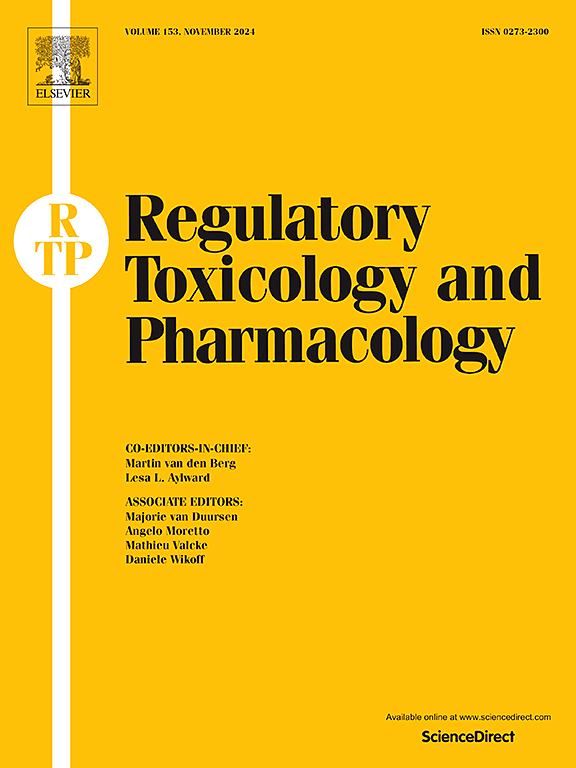A pragmatic workflow for human relevance assessment of toxicological pathways and associated new approach methodologies
IF 3.5
4区 医学
Q1 MEDICINE, LEGAL
引用次数: 0
Abstract
Currently, safety assessments of chemical substances are predominantly based on animal data. Multiple considerations call for the use of alternative testing strategies that are based on new approach methodologies (NAMs). However, the human relevance of these testing strategies is usually uncertain. This necessitates a harmonized and accepted workflow for assessing their applicability for regulatory purposes. This report proposes such a workflow, applicable for assessing the human relevance of a toxicological pathway and the relevance of NAMs related to the different components of the pathway. The workflow starts with an established toxicological pathway, of which the adverse outcome is relevant for human health risk assessment and that has sufficient weight of evidence. Human relevance is assessed through three main questions, related to the different components (steps) of the pathway, the pathology of human syndromes that have a similar adverse outcome, and quantitative aspects. The latter comprise both interspecies differences and in vitro – in vivo differences. The combined evidence is scored as ‘strong’, ‘moderate’ or ‘weak’ support of human relevance, based on expert judgement. The workflow developed was tested in a case study, through application to an AOP describing craniofacial malformations after in utero exposure to triazoles. Based on evidence collected for two of the three main questions, the case study provided moderate to strong support for human relevance of both the various components of the AOP and its associated NAMs. Furthermore, it demonstrated that the workflow is a promising approach that allows for a more transparent scientific evaluation of human relevance of toxicological pathways and associated NAMs. Therefore, despite some areas for improvement, we consider the workflow an important step forward for application of AOPs and related NAMs in human health risk assessment.
一个实用的工作流程的人类相关性评估毒理学途径和相关的新方法方法学
目前,化学物质的安全性评估主要基于动物数据。多种考虑要求使用基于新方法方法学(NAMs)的替代测试策略。然而,这些测试策略的人类相关性通常是不确定的。这就需要一个统一的和可接受的工作流程来评估它们对监管目的的适用性。本报告提出了这样一个工作流程,适用于评估毒理学途径的人类相关性以及与该途径不同组成部分相关的NAMs的相关性。工作流程从确定的毒理学途径开始,其中的不良后果与人类健康风险评估相关,并且具有足够的证据权重。人类相关性通过三个主要问题进行评估,这些问题与途径的不同组成部分(步骤)、具有类似不良后果的人类综合征的病理以及定量方面有关。后者包括种间差异和体内外差异。根据专家的判断,综合证据被评分为“强”、“中等”或“弱”支持人类相关性。开发的工作流程在一个案例研究中进行了测试,通过应用于描述子宫内暴露于三唑后颅面畸形的AOP。基于为三个主要问题中的两个收集的证据,案例研究为AOP的各种组件及其相关的NAMs的人类相关性提供了从中等到强烈的支持。此外,它还表明,该工作流程是一种很有前途的方法,可以对毒理学途径和相关NAMs的人类相关性进行更透明的科学评估。因此,尽管还有一些有待改进的地方,但我们认为该工作流程是将aop和相关namas应用于人类健康风险评估的重要一步。
本文章由计算机程序翻译,如有差异,请以英文原文为准。
求助全文
约1分钟内获得全文
求助全文
来源期刊
CiteScore
6.70
自引率
8.80%
发文量
147
审稿时长
58 days
期刊介绍:
Regulatory Toxicology and Pharmacology publishes peer reviewed articles that involve the generation, evaluation, and interpretation of experimental animal and human data that are of direct importance and relevance for regulatory authorities with respect to toxicological and pharmacological regulations in society. All peer-reviewed articles that are published should be devoted to improve the protection of human health and environment. Reviews and discussions are welcomed that address legal and/or regulatory decisions with respect to risk assessment and management of toxicological and pharmacological compounds on a scientific basis. It addresses an international readership of scientists, risk assessors and managers, and other professionals active in the field of human and environmental health.
Types of peer-reviewed articles published:
-Original research articles of relevance for regulatory aspects covering aspects including, but not limited to:
1.Factors influencing human sensitivity
2.Exposure science related to risk assessment
3.Alternative toxicological test methods
4.Frameworks for evaluation and integration of data in regulatory evaluations
5.Harmonization across regulatory agencies
6.Read-across methods and evaluations
-Contemporary Reviews on policy related Research issues
-Letters to the Editor
-Guest Editorials (by Invitation)

 求助内容:
求助内容: 应助结果提醒方式:
应助结果提醒方式:


